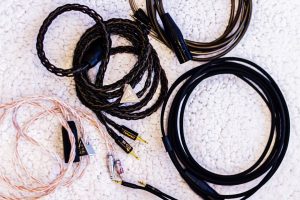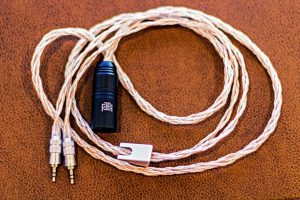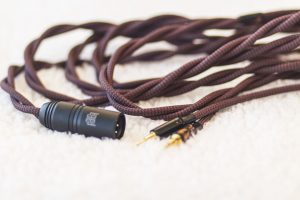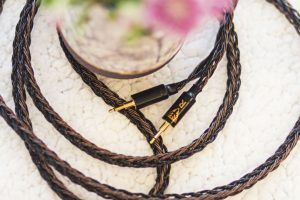Head-to-head comparison: headphone cables on the HE1000 v2
Cable controversy
A sure way to fire up the average blood pressure in a roomful of audio aficionados is to utter the word “cables.” In the extreme case, those who run their speakers off upcycled coat hangers sneer at the fools who have been parted from their money for megabuck cables. To keep this debate productive, I performed a head to head comparison of five cables, with a blind testing component. Specifically I have been asking friends and unfortunate airbnb’ers who happen to around to listen to several cables and tell me about what differences they hear, if any. The interview is unstructured and while the testing is initially blind and then we shift to an unblinded stage where people listen to whatever they want. I will summarize results in a separate post when group size is reasonable – for the moment observations are my own.

Several of the cables in this head to head comparison
Personal objectivity – for you to judge
I have never wanted cables to make a difference, mainly because I did not want one more aspect of this hobby vacuuming up my hard-earned cash. If anything, I’m biased against cables making an appreciable difference, based on various theoretical arguments about why they shouldn’t – in particular arguments indicating any reasonably-constructed cable should sound equivalent in the audio frequency band. While I have experienced significant improvement from replacing stranded speaker cable from Lowes, there were obvious oxidation issues involved, so that has done little to convince me of the relevance of cables. However, the great sounds coming out of the HE1000 v2 (see review) made me wonder how much farther I could push performance by swapping the input cable.
Five cable comparison
I gathered five headphone cables, placed in a highly resolving system (see details), playing a full range of music styles. Results described below are my own perceptions, with general results from the group to be included as they accumulate. The importance of blind testing has been noted in two studies of Stradivari violins (here and here) by Claudia Fritz et al related to the current comparison. As with high-end-cables, the exact sonic basis of the Stradivari sound is debated. The punchline of these studies was that award-winning musicians who were literally playing the the Stradivari’s could not distinguish between them and modern violins. These tests also highlight the importance of head-to-head comparison, because ears quickly adapt to the current sound signature. With these lessons in mind, I conducted blind test among the following cables, followed by unblinded testing, because people doing the listening just wanted to take over at some point.

Image shows all cables in comparison – from upper left – “Mystery Silver” cable, upper right – Norne Noetic, bottom right – Norne Draug, remaining cables are stock hifiman (original and v2 on bottom center)
Cable 1: Stock HIFIman HE1000 (from original headphone version) Few official details on this cable are available, but consensus is that it uses OCC copper (Ohno Continuous Casting – a method aimed at producing fewer, larger crystals in the wire).
Cable 2: Stock HIFIman HE1000 v2
Cable 3: Norne Audio “Zoetic” Pure copper OCC litz. 2x21awg per channel (equivalent of 4x24awg). It uses a combination of textile cores and carbon pvc cores internally and is a “pure textile” cable – no polymer dielectric.
Cable 4: Norne Audio “Draug” Pure copper OCC litz. Pure cotton cores around each of the 24-wires, 8 x 23awg total (equivalent to 4x20awg). Uses Norne’s multi-wire geometry per 23awg wire.
Cable 5: Norne Audio Mystery Silver cable (non-production) ~23awg of silver + 26awg of copper per each polarity (12-wire, 2 x silver 1 x copper wires per polarity)
As seen in the photographs, the topology of these wires varied significantly – from a complex weave on the Draug to a sort of lazy spiral inside the stock v2 cable tube. While the copper Norne cables were thicker than stock, they were actually more flexible. All cables except the stock v2 cable slide around easily, which is helpful as you shift around while listening.
The HIFIman cables were sonically indistinguishable from each other, and differed from all of the Norne cables in that they offered slightly lower resolution than any of the cables from Norne. I would not go so far as to as to call them muffled or make claims that veils have been lifted, but the improvement is noticeable in back-to-back comparisons. This issue of resolution was uniform across the frequencies – it did not appear to be a case of less treble information in the upgraded cables, as there were clear cases of increased bass and midrange detail. Between the cable options from Norne, the bass on the Draug and the demo silver cable was indistinguishable. However, using the silver cable sopranos showed a degree of dryness in their upper registers that made me want to offer them some water.

Bass emphasis was the largest distinction between the Noetic and Draug – both cables are OCC copper, but there was a slight feeling of slowness to the bass on the noetic, which I’m guessing actually has to do with midbass detail, along with the increased bass amplitude. If I had to put a number on it I’d say there was a 0.5 db increase in bass frequencies up to ~400Hz on the Noetic. I believe this effect extended into the mids because overall there was a feeling of solidity to male vocals on the Noetic that was not quite matched by the Draug or silver cable.

Image above, Norne Audio Noetic
I have not mentioned specific properties of the Draug because it sat in between the Noetic and silver cable, with neither bass or tremble emphasis.

Image above, Norne Audio Draug
Training effects
I found that my ability to distinguish between cables improved over time, after several hours of swapping back and forth. This basis for improved classification is due to an intentional strategy of focusing on particular elements that highlight distinctions between cables. Conversely, can I tell the difference between these cables on 5 seconds of any given track? Certainly not. Do you need back-to-back comparisons to notice the differences between cables? I did, and would not trust myself to accurately compare the “sound” of various cables without the head-to-head comparison framework. Finally, could I live happily ever after with any of them? Any cable except the stock v2 cable would be acceptable, but the point of this comparison is not about needing one of these cable like oxygen, but about increasing your enjoyment.
Value proposition
If you thought a cable couldn’t annoy you, think again. I suspect the poor ergonomics of the HE1000 v2 cable will spur many listeners to look at upgrade options. Headphone cables dangle around exposed skin on your neck, shift around as you listen and overall tend to interact with you more than any equipment other than the headphone itself. Therefore the stickiness of the stock cable has a significant negative impact on the listening experience. In contrast, the cables loaned from Norne are pleasant to handle, can be customized as you wish, and have solid construction.
While ergonomics may drive many people to upgrade in the specific case of the HE1000, once you make the decision to upgrade, the cost/benefit analysis of audio quality will come into play. I don’t have exact prices on the demo cables from Norne, and one of them isn’t even a production model, but generally cables of several feet in length range from $300-600,with a completely customized appearance. For many people a 10-20% premium over the price of the headphones for a cable that noticeably improves your enjoyment, is worth it, and (full disclosure) I felt it was worth it to plunk down cash for the Noetic. The interest in upgrading was in part driven by poor ergonomics of the v2 cable, but reinforced by the real improvements in sound quality, as demonstrated by my excessive testing.
Prices for alternative cables also help to define the question of value. As a lower-priced contrast, replacement HE1000 cables from HIFIman are $100 and they list various copper-silver hybrids that go to $400. Options for HE1000 cables from Kimber and Double helix cable (DHC) can be well over a thousand dollars. Such pricing really needs to deliver results, because this is in the context of headphones, wherein a couple hundred bucks buys you great sound. In the context of loudspeaker systems, it is somehow more conceivable to spend a thousand dollars on the cabling for speakers which cost several times that amount. However, it could be argued that if you are in a financial position to spend a thousand dollars on a headphone cable, then you don’t have to care how much of a difference it makes – any increment is enough. I did have the chance to briefly listen to the Kimber Axios cable on the HE1000 at Axpona, but found it literally so much louder that the alternative cable that I think the latter may have actually been broken, so further testing is needed.
Conclusion
To me, the broader question of the relevance of cables to performance in loudspeaker systems remains open, as these tests were performed in a highly resolving system. However, the rapid comparisons I performed were sufficient to convince me that some distinctions between cables can be reliably detected. The degree to which this affects your purchases will vary, but coupled with the annoying design of the stock cable, the audible differences in cables were enough to convince me to swap for one of the Norne cables.

Limitations
Comparison testing – Due to limitations on human acoustic memory, which is well under a minute, I attempted to make transitions between cables as fast as possible. However, the transition was not seamless and cable swapping even with four pairs of hands, left a ~3 second gap between music playing on one cable to music playing on the next cable. Ideally I’d like to vary all parameters of the test – listening to many clips from different genres, being forced to identify what cable is in use at any time. Logistically that is not possible for me, but seems worth it for large cable producers to invest in such a setup.
Single headphone model – While headphones eliminate the room, there are still variability due to the pinna, so perhaps a comparison on IEM’s would be superior for the purpose of testing cables, as they eliminate one more variable. In the broader sense, we’re only comparing cables on a single headphone (HE1000 v2), so results from these same cables on other headphones may be more or less pronounced.
Uncontrolled music – I did not play a standard set of test tracks for each person who listened to the cables. Rather they listened to whatever they wanted to from my music collection or their own, as long as it was lossless. This practice likely increased the variability of perceptions, but I thought it was essential for listeners to be familiar with the music on which they were evaluating the cables, so they could focus on specific components or phrases.
Equipment setup
Several components of the test system may increase the likelihood of hearing distinctions between cables. The ES9018 chip in my dac is known for high levels of detail. This feeds an OTL amplifier, which means you get tube-goodness without low-end rolloff, because there simply is no transformer to saturate, In comparison with a solid-state F5, I’ve noticed slightly less “zing” from OTL, but there’s still more treble energy there than for a typical SET. The headphones used for all cables are the HIFIman HE1000 v2, which is among these best headphones most of us will have a chance to hear; therefore, if any real differences are found among cables, these headphones have a good chance at revealing them.
Thank you
Special thanks to Trevor Goldman of Norne Audio, who had the confidence in his products to loan them out for blind testing.